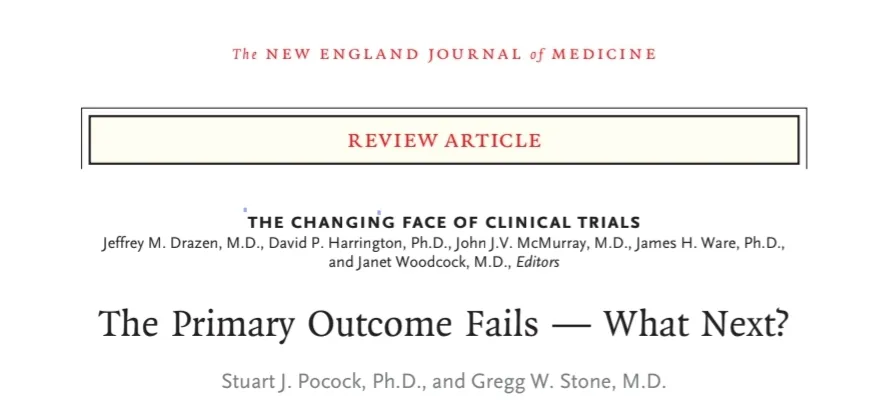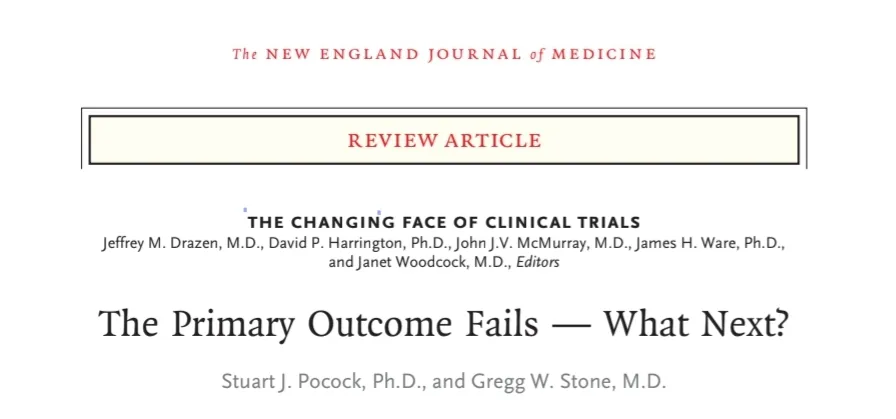
The article “The Primary Outcome Fails — What Next?” published in the New England Journal of Medicine provides critical insights for clinical researchers and biostatisticians regarding the interpretation of clinical trial results, particularly when primary outcomes do not achieve statistical significance. This blog post will break down the article’s key sections, offering examples and explanations relevant to early-career professionals in the field.
https://www.nejm.org/doi/pdf/10.1056/NEJMra1510064

Clinical trials are designed with a prespecified hypothesis, which is crucial for avoiding false positive claims based on exploratory analyses. However, a common misconception is to label trials as simply “positive” or “negative” based solely on whether the p-value is below 0.05. The authors argue that p-values should be viewed as a continuum, where smaller values indicate stronger evidence for treatment effects. Additionally, confidence intervals provide valuable context regarding the uncertainty surrounding estimated effects.
When a trial’s primary outcome fails to reach significance, researchers should consider several critical questions that can guide their interpretation and future actions:
Researchers should look for any trends suggesting treatment benefits, even if p-values exceed 0.05. For instance, in the TORCH trial, although the primary outcome (death from any cause) had a p-value of 0.052, significant benefits were observed in secondary outcomes like COPD exacerbations. This indicates that the trial’s findings warrant a more nuanced interpretation rather than being labeled as entirely negative.
A trial may fail to detect true treatment effects due to insufficient sample size, leading to type 2 errors. The CIBIS II trial exemplifies this; an earlier trial with only 621 patients showed no significant benefit from bisoprolol, while a larger follow-up with 2,647 patients demonstrated a significant reduction in mortality (hazard ratio 0.66). This highlights the importance of adequate power in study design.
Choosing an appropriate primary outcome is vital for meaningful results. In the PROactive trial, a composite outcome diluted potentially significant findings due to random noise from additional components. A more focused primary outcome could have yielded clearer insights.
Selecting the right patient population is crucial. The SHIFT trial showed that ivabradine significantly reduced cardiovascular death or hospitalization for heart failure in patients with chronic heart failure, while earlier trials involving stable coronary disease did not yield positive results. This underscores the need for appropriate patient selection based on mechanistic understanding.
Determining correct dosages can greatly influence outcomes. The PEGASUS-TIMI 54 trial tested different doses of ticagrelor and found that a lower dose was more effective than higher doses or placebo, illustrating how dosage selection can impact trial success.
Poor adherence to study protocols can obscure true treatment effects. In the TOPCAT trial, analysis limited to specific countries revealed significant benefits of spironolactone that were not apparent in the overall analysis due to protocol deviations or atypical patient enrollment.
When a new treatment does not show superiority over an active control, noninferiority claims can be valuable if prespecified in study design. The VALIANT trial demonstrated this by concluding that valsartan was noninferior to captopril despite showing no superiority.
While subgroup analyses can provide insights, they should be approached cautiously when overall results are negative, as they may mislead interpretations without strong mechanistic justification.
The article emphasizes that when primary outcomes fail, researchers should engage in thorough investigations using structured questions rather than hastily concluding ineffectiveness. By considering factors such as study power, outcome definitions, and population appropriateness, clinical researchers can derive meaningful insights from their trials.This comprehensive approach is essential for advancing medical knowledge and improving patient outcomes through evidence-based practice, making it an invaluable resource for early biostatisticians and clinical researchers navigating the complexities of clinical trial results effectively.